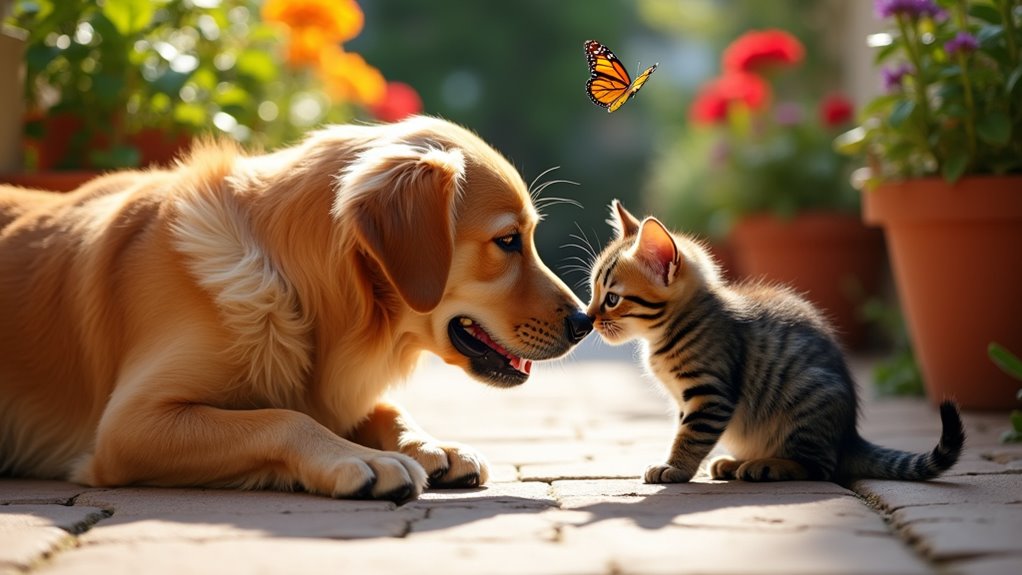When introducing different pets, start by researching their compatibility and prepare separate spaces for gradual contact. Use barriers and supervised visits to allow them to get accustomed to each other’s scents and presence. Watch their body language closely and reinforce positive interactions with treats and praise. Be patient, as some animals need weeks to adjust comfortably. If you’d like to learn more about creating peaceful introductions, you’ll find helpful tips to ensure safety and harmony.
Key Takeaways
- Start with separate spaces and allow visual and olfactory contact before direct interaction.
- Conduct brief, supervised meetings, gradually increasing duration based on animals’ comfort levels.
- Observe body language for stress or aggression, and intervene if needed to prevent conflicts.
- Use positive reinforcement and enrichment to promote calm behavior and bonding during introductions.
- Be patient, recognizing that some animals may need days or weeks to adjust and integrate peacefully.

Introducing different animals to each other can be a rewarding experience, but it requires careful planning to guarantee safety and success. The key to a smooth introduction lies in understanding species compatibility and implementing gradual introductions. Not all animals are naturally compatible, so it’s crucial to research how different species interact in the wild and in captivity. Some animals may see others as prey, while some may be indifferent or even friendly. By evaluating species compatibility beforehand, you can set realistic expectations and avoid potential conflicts that could harm your pets.
Understanding species compatibility is essential for safe, successful animal introductions.
When you’re ready to introduce your animals, start with gradual introductions. This process allows each animal to adjust to the presence of the other without feeling threatened. Begin by keeping the animals separated in adjoining rooms or behind a barrier, such as a gate or a screen, so they can see and smell each other without direct contact. Observe their reactions closely, noting any signs of stress, curiosity, or aggression. If both animals appear calm and curious, you can move to the next step. If either shows signs of distress or hostility, take a step back and give them more time to get accustomed to each other’s scent and presence.
Once they seem comfortable with visual contact, you can proceed to supervised, in-person meetings. Keep these initial interactions brief—just a few minutes—and always stay vigilant. Use treats or praise to reinforce positive behavior and to help create a positive association with each other’s presence. Be prepared to intervene if things escalate. It’s important not to force interactions; instead, let the animals set the pace. Over time, gradually increase the duration of these supervised meetings, always monitoring their body language for signs of stress or aggression. Incorporating positive reinforcement techniques can further facilitate smooth interactions between different species.
Throughout this process, patience is essential. Some animals may take days or even weeks to accept each other, especially if their species or personalities differ substantially. Providing enrichment activities can help reduce stress and promote positive interactions during this time. Additionally, understanding animal behavior and individual temperaments can significantly improve your chances of a successful integration. Recognizing the distinctive traits of each species involved can help tailor your approach and set realistic expectations. Also, consider that species-specific needs may influence how animals interact during introduction, so tailoring your approach accordingly can be beneficial.
Ultimately, successful integration depends on understanding species compatibility and practicing gradual introductions. With patience, careful observation, and respect for each animal’s comfort level, you can foster a peaceful coexistence among your pets, making their lives—and yours—more fulfilling.
Frequently Asked Questions
How Long Does It Typically Take for Animals to Get Used to Each Other?
You might wonder how long it takes for animals to get used to each other. Typically, the socialization timeline varies based on species and individual temperaments, but it can take anywhere from days to several weeks. During this period, patience during introductions is key. Keep interactions gradual, observe their behavior, and don’t rush the process. With consistent, calm exposure, your pets will gradually build trust and become comfortable together.
What Signs Indicate Animals Are Comfortable During Initial Introductions?
Many believe animals adapt quickly, but research shows comfort signals develop over time. During initial introductions, look for positive body language cues like relaxed postures, wagging tails, or gentle approach. Calm vocalizations and soft eye contact also indicate ease. If animals continue to display these signs, they’re likely comfortable. Stay attentive to subtle body language cues and vocalizations to make certain a smooth, stress-free introduction, fostering trust between your pets.
Can Introducing Animals Cause Long-Term Behavioral Changes?
Introducing animals can cause long-term behavioral changes by influencing their social bonding and prompting behavioral adaptation. As you introduce new animals, observe their interactions closely, and positive experiences can strengthen trust and friendship. Over time, this can lead to more confident, adaptable pets. However, negative encounters might result in stress or aggression. Your careful management guarantees the long-term success of their social bonds and behavioral growth.
Are There Specific Environments Better for Animal Introductions?
Think of introducing animals like planting a garden—you need the right environment to thrive. An appropriate space provides room for animals to explore without feeling trapped. Scent swapping helps them become familiar with each other’s presence. Choose a neutral, quiet area, free of distractions, to foster calm interactions. This setting minimizes stress, making the introduction smoother and increasing the chance of a positive, long-lasting bond.
How Do Age Differences Affect Interspecies Introductions?
Age differences markedly influence interspecies introductions because age compatibility and social maturity matter. You should consider that younger animals often have more energy and curiosity, which might overwhelm older pets. Conversely, older animals tend to be more settled and may not tolerate boisterous younger ones. By evaluating each animal’s social maturity and choosing age-compatible pairs, you help guarantee smoother introductions and foster positive relationships.
Conclusion
Remember, introducing different animals can be rewarding if done patiently. You might worry about conflicts or stress, but with gradual introductions and supervision, most pets adapt well. Keep a calm, positive attitude and give them time to get used to each other. Don’t rush the process—trust that, with patience, your pets can form surprising and delightful bonds. After all, a little effort now can lead to lifelong friendship and a more harmonious home.










